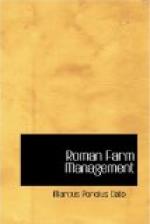substances of which it is composed, as a chalky soil,
a gravelly soil, or what ever else may be its distinguishing
quality. And as there are different varieties
of soil so each variety may be subdivided according
to its quality, as, for example, a rocky soil is either
very rocky, moderately rocky or hardly rocky at all.
So three grades may be made of other mixed soils.
In turn each of these three grades has three qualities:
some are very wet, some very dry, some moderate, These
distinctions are of the greatest importance in respect
of the crops, for the skilled husbandman plants spelt
rather than wheat in wet land, and on dry land barley
rather than spelt, in medium land both. Furthermore
there are still more subtle distinctions to be made
in respect of all these kinds of soil, as for example
it must be considered in respect of loam, whether
it is white loam or red loam, because white loam is
unfit for nursery beds, while red loam is what they
require. But the three great distinctions of quality
of soil are whether it is lean or fat, or medium.
Fat soils are apparent from the heavy growth of their
vegetation, and the lean lie bare; as witness the
territory of Pupinia (in Latium), where all the foliage
is meagre and the vines look starved, where the scant
straw never stools, nor the fig tree blooms, while
for the most part the trees are as covered with moss
as are the arid pastures. On the other hand, a
rich soil like that of Etruria reveals itself heavy
with grain and forage crops and its umbrageous trees
are clean of moss. Soil of medium strength, like
that near Tibur, which one might say is rather hungry
than starved, repays cultivation in proportion as
it takes on the quality of rich land.”
“Diophanes of Bithynia,” said Stolo, “was
very much to the point when he wrote that the best
indication of the suitability of soil for cultivation
can be had either from the soil itself or from what
grows in it: so one should ascertain whether
it is white or black, if it is light and friable when
it is dug, whether its consistency is ashy, or too
heavy: or it can be tested by evidence that the
wild growth upon it is heavy and fruitful after its
kind.[65] But proceed and tell us of your third division,
which relates to the measurement and laying out of
the farm.”
Of the units of area used in measuring land
X. Scrofa resumed: “Every country has its
own system for measuring land. In Further Spain
the unit of area is the jugum, in Campania
the versus, here in the Roman country and among
the Latins it is the jugerum. They call
a jugum the area which a pair of oxen can plough
in a day. The versus is one hundred feet
square: the jugerum is the area containing
two square actus: the actus quadratus
or acnua, as it is called by the Latins, measuring
120 feet in width and as much in length.[66] The smallest
fraction of a jugerum is called a scripulum




